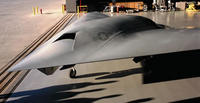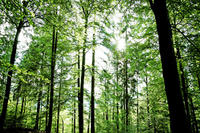-
APDN helps prevent government use of fake microchips
Applied DNA Sciences Inc. (APDN) recently announced that it is working with the U.S. government to prevent the use of counterfeit microchips in mission-critical hardware that can lead to potential life-threatening equipment failures; the company is launching a pilot program in conjunction with the government that is designed to ensure that phony microchips do not enter critical supply chains; with the growth of outsourcing and global production chains, pirated microchips have begun appearing in everything from cell phones to fighter jets; the New York based firm specializes in the development of plant based DNA markers that can be safely inserted into any material to ensure its authenticity
-
-
Phantom Ray completes maiden flight

Phantom Ray, Boeing’s fighter-sized unmanned airborne system (UAS), took to the early morning skies on 27 April at Edwards Air Force Base in California for its maiden flight; Phantom Ray is one of several programs in Boeing’s Phantom Works division, including Phantom Eye, which is part of a rapid prototyping initiative to design, develop, and build advanced aircraft and then demonstrate their capabilities
-
-
Portable technology provides drinking water, power to villages, military
Researchers have developed an aluminum alloy that could be used in a new type of mobile technology to convert non-potable water into drinking water while also extracting hydrogen to generate electricity; such a technology might be used to provide power and drinking water to villages and also for military operations
-
-
Michelin developing puncture-proof tires
Michelin, the French tire manufacturer, has invented the “Tweel” which could make vehicles impervious to punctures or even explosions; The Tweel is a combination tire and wheel that infuses the best elements of both designs; the Tweel has no pneumatic rubber shell leaving nothing to deflate or puncture; the Tweel resembles a wagon wheel with polyurethane spokes and rubber for the treads, but is not entirely rigid as the spokes are flexible; despite these improvements in design, Tweels have several flaws that have kept them from being widely implemented
-
-
What past rises of sea levels tell us about future rises
During a period of high atmospheric carbon dioxide levels three million years ago — the mid-Pliocene climate optimum — sea levels were anywhere between 15 and 100 feet higher than at present because water that is now locked up in glaciers as ice circulated freely through the oceans; by understanding the extent of sea level rise three million years ago, scientists hope more accurately to predict just how high the seas will rise in the coming decades and centuries due to global warming
-
-
U.K. universities accused of being "hotbeds of Islamic extremism"

British universities have been accused of being fertile breeding grounds for violent extremism; a recent investigation by British MPs claims that Islamic fundamentalism has flourished at universities and school officials have done little to stop it; school officials have denied these charges and insist that the report is entirely lacking in factual evidence; university vice-chancellors said the parliamentary report conflates the fact that young people are susceptible to radicalization and that a very large percentage of young people in the United Kingdom attend universities
-
-
Homeland security solution competition
HSTV announced its Ideas for a Secure Tomorrow awards — a video competition that seeks the best ideas for improving security at both the local and national level; entries are due by 1 August 2011
-
-
Study finds natural gas releases twice as much greenhouse gas as coal
A new study shows that natural gas is not as environmentally friendly as previously thought, dealing a major blow to environmentalists who viewed it as a “bridge fuel” to cleaner energy alternatives; researchers found that the greenhouse-gas footprint of shale gas over a twenty year period was at least 20 percent higher than coal and could even be “more than twice as great”; the study was quick to draw criticism from oil and gas companies for its use of shoddy data; the study also outlines multiple ways that the oil and gas companies could reduce methane emissions by up to 90 percent during the drilling process
-
-
West Texas towns face impending water shortage
West Texas is facing a dire drought that has local officials scrambling to find additional sources of water for thirsty residents; since last October, West Texas has only seen about one-tenth of an inch of rain, and now two of the three reservoirs that cities in the Permian Basin depend upon are nearly empty; the third reservoir is 30 percent below capacity; without significant rain soon, all three reservoirs will be dry by January 2013; residents have been restricted to only three days of outdoor watering; the region faces limited options for additional sources of water and plans will be expensive to implement
-
-
Busy hurricane season ahead for U.S.
Forecasting organizations predicts that the coming hurricane season in the United States will see 15 named storms, 8 hurricanes, and 4 intense hurricanes (category 3 or greater); these 2011 forecast numbers are above the long-term (1950-2010) averages of 12 named storms, 7 hurricanes, and 3 intense hurricanes
-
-
U.K. struggles to reduce water usage as supplies dwindle

An uncharacteristically warm and dry spring in the United Kingdom has forced water companies to begin conserving water, but a recent survey indicates that the method currently employed is widely unpopular and grossly affects low income families; some reservoirs are 20 percent below normal levels and eleven rivers are at their lowest in twenty years; in 1989 the British government mandated that all new homes have water meters installed and introduced a usage plan which charges households based on the amount of water they consume; the plan has proven effective in reducing water usage, but costs have increased by more than 50 percent
-
-
Recycled concrete saves money
Purdue University civil engineers are working with the Indiana Department of Transportation to perfect the use of recycled concrete for highway construction, a strategy that could reduce material costs by as much as 20 percent; “If you are going to pave, you may have to remove the old concrete and break it into pieces anyway, so recycling makes sense,” one of the researchers says
-
-
Student aero-design competition to be held next week
The Aero Design competition, to be held at the end of the month, is intended to provide undergraduate and graduate engineering students with a real-life engineering challenge; the organizers say the competition has been designed to provide exposure to the kinds of situations that engineers face in their real-life work environment; students will find themselves performing trade studies and making compromises to arrive at a design solution that will optimally meet the mission requirements while still conforming to the configuration limitations
-
-
Researchers develop paper that is stronger than steel
Work by Australian researchers is a step forward in the development of a material that has the potential to revolutionize the automotive, aviation, electrical, and optical industries; the composite material based on graphite that is a thin as paper and ten times stronger than steel
-
-
Past experience shows that Earth can recover from global warming

When faced with high levels of atmospheric carbon dioxide and rising temperatures fifty-six million years ago, the Earth increased its ability to pull carbon from the air;this led to a recovery that was quicker than anticipated by many models of the carbon cycle — though still on the order of tens of thousands of years, a new study finds; researchers found that more than half of the added carbon dioxide was pulled from the atmosphere within 30,000 to 40,000 years, which is one-third of the time span previously thought
-
More headlines
The long view
New Technology is Keeping the Skies Safe
DHS S&T Baggage, Cargo, and People Screening (BCP) Program develops state-of-the-art screening solutions to help secure airspace, communities, and borders
Factories First: Winning the Drone War Before It Starts
Wars are won by factories before they are won on the battlefield,Martin C. Feldmann writes, noting that the United States lacks the manufacturing depth for the coming drone age. Rectifying this situation “will take far more than procurement tweaks,” Feldmann writes. “It demands a national-level, wartime-scale industrial mobilization.”
How Artificial General Intelligence Could Affect the Rise and Fall of Nations
Visions for potential AGI futures: A new report from RAND aims to stimulate thinking among policymakers about possible impacts of the development of artificial general intelligence (AGI) on geopolitics and the world order.
Smaller Nuclear Reactors Spark Renewed Interest in a Once-Shunned Energy Source
In the past two years, half the states have taken action to promote nuclear power, from creating nuclear task forces to integrating nuclear into long-term energy plans.
Keeping the Lights on with Nuclear Waste: Radiochemistry Transforms Nuclear Waste into Strategic Materials
How UNLV radiochemistry is pioneering the future of energy in the Southwest by salvaging strategic materials from nuclear dumps –and making it safe.
Model Predicts Long-Term Effects of Nuclear Waste on Underground Disposal Systems
The simulations matched results from an underground lab experiment in Switzerland, suggesting modeling could be used to validate the safety of nuclear disposal sites.
